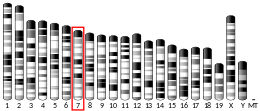| MRGPRX4 |
|---|
|
| Identifiers |
|---|
| Aliases | MRGPRX4, GPCR, MRGX4, SNSR6, MAS related GPR family member X4 |
|---|
| External IDs | OMIM: 607230; MGI: 3033139; HomoloGene: 86184; GeneCards: MRGPRX4; OMA:MRGPRX4 - orthologs |
|---|
| Gene location (Human) |
|---|
 | | Chr. | Chromosome 11 (human)[1] |
|---|
| | Band | 11p15.1 | Start | 18,172,837 bp[1] |
|---|
| End | 18,174,280 bp[1] |
|---|
|
| Gene location (Mouse) |
|---|
 | | Chr. | Chromosome 7 (mouse)[2] |
|---|
| | Band | 7|7 B4 | Start | 47,670,719 bp[2] |
|---|
| End | 47,677,345 bp[2] |
|---|
|
| RNA expression pattern |
|---|
| Bgee | | Human | Mouse (ortholog) |
|---|
| Top expressed in | - middle temporal gyrus
- adipose tissue
- lactiferous duct
- temporal lobe
- brain
- cerebral cortex
- spinal ganglia
- vulva
|
| | | More reference expression data |
|
|---|
| BioGPS |  | | More reference expression data |
|
|---|
|
| Gene ontology |
|---|
| Molecular function | - signal transducer activity
- G protein-coupled receptor activity
| | Cellular component | - integral component of membrane
- plasma membrane
- membrane
- integral component of plasma membrane
| | Biological process | - G protein-coupled receptor signaling pathway
- signal transduction
| | Sources:Amigo / QuickGO |
|
| Orthologs |
|---|
| Species | Human | Mouse |
|---|
| Entrez | | |
|---|
| Ensembl | | |
|---|
| UniProt | | |
|---|
| RefSeq (mRNA) | | |
|---|
| RefSeq (protein) | | |
|---|
| Location (UCSC) | Chr 11: 18.17 – 18.17 Mb | Chr 7: 47.67 – 47.68 Mb |
|---|
| PubMed search | [3] | [4] |
|---|
|
| Wikidata |
| View/Edit Human | View/Edit Mouse |
|



















